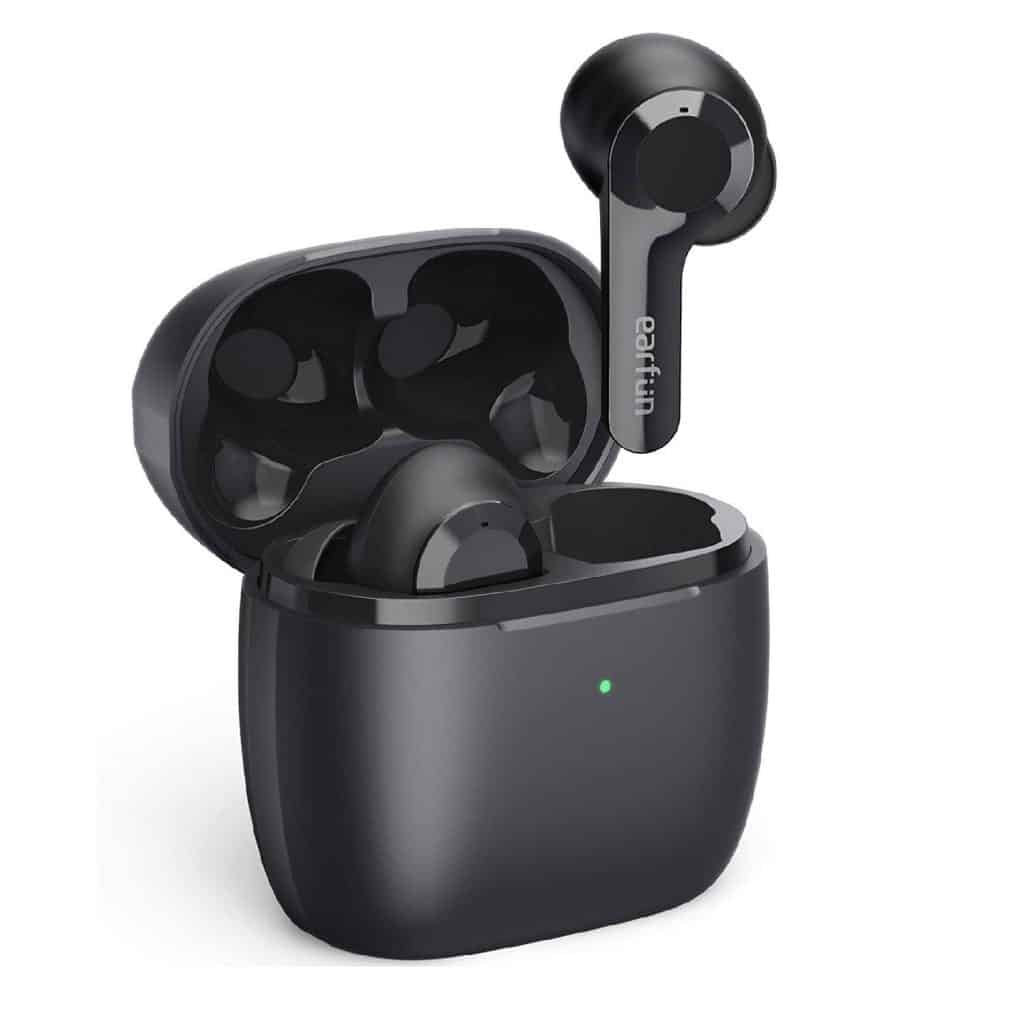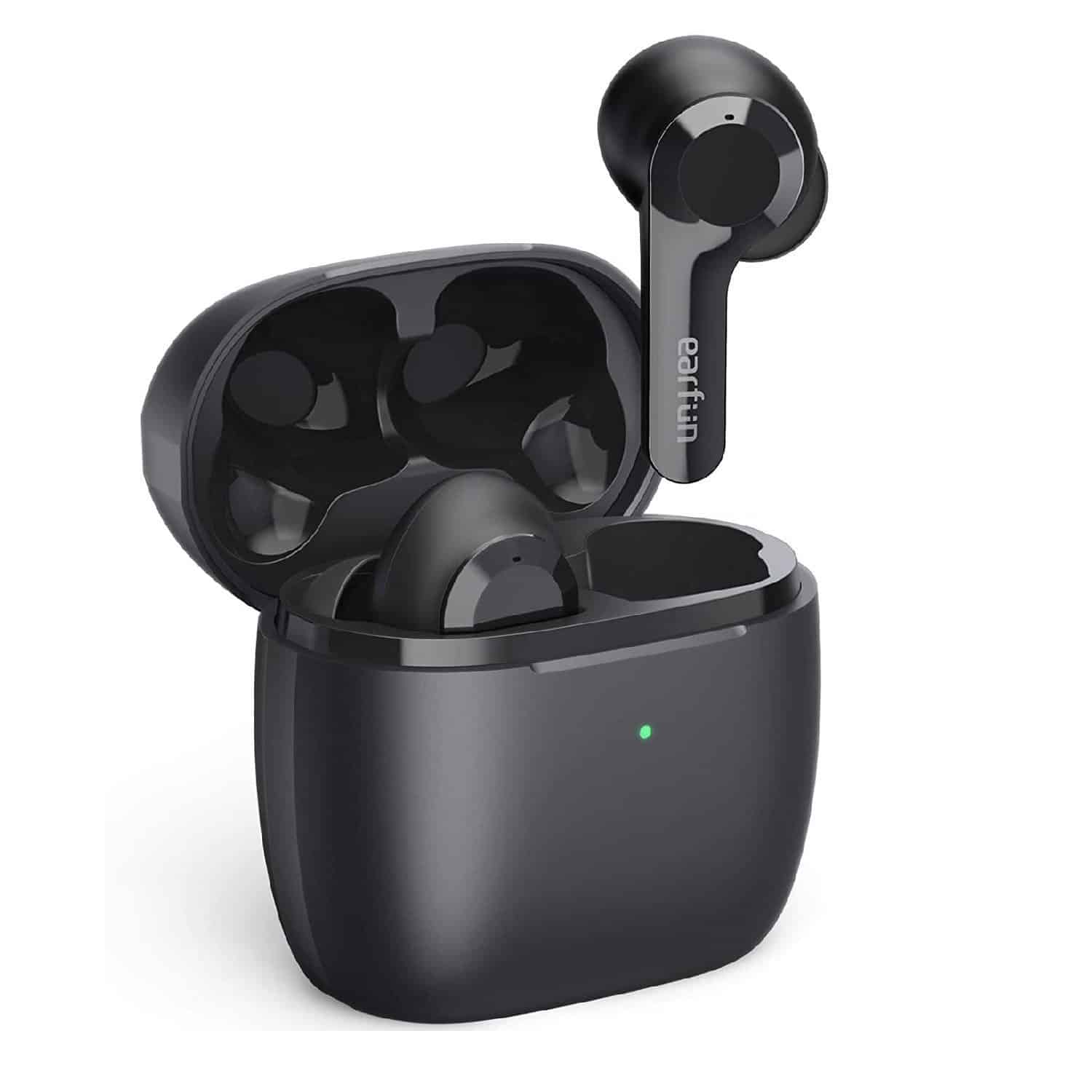Table of Contents
amazon EARFUN AIR reviews
Not the first product, nor the most advanced product of the EarFun audio company, EarFun Air is in a slightly ‘halfway’ position between its Free and Air Pro brothers. That can be a double-edged sword when you can save a bit of money by buying the Free or try a little harder to opt for the Air Pro with its strong, active noise cancellation.
But if it does its job well, EarFun Air will most likely become a mid-range option worth buying, balancing performance and price. So which scenario comes true, we will evaluate Air together to find out the answer.
The packaging of products from EarFun is also nothing special, although the performance inside is often beyond the price range!
The headphones and charging case are placed on a thick layer of padding, making me rest assured that the product will be intact during transportation.
The headset’s accessory set includes a USB Type-C charging cord (long form) and three more rubber pads. The cushion of this pair of headphones has a rather short clip, which can also be a way to bring the diaphragm closer to the user’s ear, increasing sound transmission.
A special feature of EarFun is that each pair of its headphones comes with a very different type of charging case, simply because each pair has a different design. Air’s box reminds me of the box of Jabra ear pairs like 75t, for example, but placed vertically instead of horizontally!
Right in the charging box, we find one big advantage of the Air for its brothers, which is battery life. The headset has a total use time of up to 35 hours, higher than the 32-hour mark of the Air Pro pair. 35-hours, which means if you listen to music for up to 5 hours a day continuously (it doesn’t sound very practical), it will take a whole week to run out of battery, which is very respectable.
Go to the main component: the earpiece. EarFun Air has a ‘tail’ design similar to the Air Pro version but with a slimmer, rounded, and less angular tail. Because of that, this pair of headphones look more ‘conventional,’ losing a bit of the masculine and strong look of the Pro pair.
In return, EarFun Air still retains the touch surface. The proximity sensor automatically interrupts the music every time the user removes the headset – an upgrade compared to the Free low-end pair of headphones.
Besides, this pair of headphones is also IPX7 waterproof, higher than the IPX5 of the Air Pro pair. With such a high waterproof standard, the Air does not stop using it for exercise; you can completely use the headset to shower, swim, or dip in the water without fear of damage. This difference in water resistance is also possible because the Pro version has to integrate up to 6 microphones for ANC noise cancellation. The Air only needs 4 to focus on conversation purposes!
Lack of active noise cancellation, but this pair of headphones still has very good (natural) passive noise cancellation simply because the earpiece is made thick; when put in the ear, it will fill the gaps in the ear cavity. The Air pair has blocked up to approximately 80% of the noise outside; if you want to get another 20%, perhaps users will have to try a little more to invest in the Pro pair.
Responsible for the sound reproduction for the EarFun Air headphones is a pair of Dynamic 6mm drivers with the upgrade point of using PEEK + PU dual diaphragm. This dual-diaphragm technology sounds quite similar to LG’s TONE Flex headphones. Still, the Korean electronics company uses PE and metal film, so perhaps the technology application of the two companies is different. So, in fact, how does this pair of headphones sound?
Like the Air Pro, the Air headphones aim for a rich, thick sound, with a gentle V-shape to bring a little excitement to the music. In the first time listening, I feel the bass of this pair of headphones is quite a lot, even to the point of being redundant, but perhaps after a burn-in period, the bass is softer, stopping at an above-average level. In the song Light it up by Robin Hustin x TobiTomorrow, the bass makes a strong impression by emphasizing each hit, then gradually reducing the volume and deepening the sub-bass.
As usual, the midrange of a pair of vibrant sound-oriented headphones will have to give up a bit of ground for the remaining two bands so that the position will be placed a little behind. However, EarFun Air compensates for this point by creating a full mid-tone, with both Air and vocal tones, especially the high-mid not sinking to rebalance the overall sound. Diana Krall’s voice in Little Girl Blue is warm, comfortable, and laid back; on the contrary, it is not overwhelmed by the contrabass sound because of its thickness.
The treble of this pair of headphones is quite similar to the name that EarFun gave it, quite Airy when it reached the highest notes. The expression of this treble is quite bright, more inclined to the electronic direction; when combined with deep bass, it creates a contrast between the first and last two bands, making the song seem more energetic and the music pretty cool!
‘Middle’ but not to be missed
EarFun Air reminds me of the Sony XB-2x speakers, when both are mid-range products and show their strengths, bringing valuable upgrades compared to the low-range version, which has a lower selling price, more affordable than the high-end option. That is a ‘middle’ product, but it’s worth considering, especially for those who don’t need the strong, active noise cancellation of the Air Pro version.

